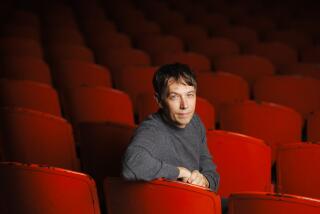William A. Fraker dies at 86; Hollywood cinematographer
- Share via
William A. “Bill” Fraker, a cinematographer who was nominated for six Academy Awards including for “Looking for Mr. Goodbar,” “Heaven Can Wait” and “1941,” died Monday at Cedars-Sinai Medical Center in Los Angeles. He was 86 and had cancer.
Fraker, a larger-than-life figure, was one of America’s most respected cinematographers, known as much for the enduring images he crafted on classic movies like “Rosemary’s Baby” and “One Flew Over the Cuckoo’s Nest” as for his efforts to mentor young camera operators.
“He was an icon as far as cinematographers and filmmakers go,’’ said Owen Roizman, past president of the American Society of Cinematographers. “His loss will be immeasurable.”
Fraker was part of a group of young cinematographers that included Vilmos Zsigmond, Laszlo Kovacs and Nestor Almendros who rose through the ranks of the studio system and helped usher in a golden era of filmmaking in the 1970s.
“We’re all heartbroken,” said Richard Crudo, vice president of the American Society of Cinematographers. “Billy always represented to me the epitome of the Hollywood filmmaker.”
Born Sept. 29, 1923, in Los Angeles and raised in Boyle Heights, Fraker joined the Navy and served in the Pacific during World War II. After attending the USC School of Cinema on the GI Bill, Fraker began work as a photographer’s assistant, following in the footsteps of his father, a noted studio photographer during the 1920s. His first project involved a Marilyn Monroe calendar.
He got his start as a camera operator on the popular TV show “The Adventures of Ozzie and Harriet” and landed his first job as a cinematographer on a feature film in the quirky 1967 drama “Games.”
Fraker went on to work with some of the biggest names in the business, including Roman Polanski, Steven Spielberg and Milos Forman, developing a reputation as an affable and calming influence on big-budget Hollywood sets with egos to match. He compiled nearly 45 feature film credits in a career spanning 32 years. He directed the 1970 western “Monte Walsh” starring Lee Marvin and Jack Palance.
A consummate perfectionist, Fraker would go to extraordinary lengths to capture the best shot. During the filming of the 1968 Steve McQueen movie “Bullitt” in San Francisco, he hoisted a camera while strapped on to the front of a Mustang going more than 100 mph to shoot a car chase scene.
“They went so fast his white beard flew up on his face,” said his longtime friend and colleague Floyd Mutrux, the writer, actor and director. “He couldn’t see where he was coming or going, but he got the shot.”
Fraker did not advocate a particular style, however, arguing that the look of the movie should be determined by the film itself. “I don’t agree with a cinematographer putting his stamp on a picture,” he once said.
“For me, Billy represented the romance of our profession,” said Michael Goi, president of the American Society of Cinematographers. “He liked to present people and actors in a way that made them look and feel absolutely their best.”
Fraker had a fascination with the early days of rock ‘n’ roll. One of his favorite movies was the 1978 film “American Hot Wax,” loosely based on the Cleveland disc jockey Alan Freed.
He was active in the American Society of Cinematographers, serving as the group’s president several times. The organization presented him with a Lifetime Achievement Award in 2000. He spent the last several years teaching at USC, giving his last class only two weeks ago.
“He was teaching right up until the last second,” Mutrux said. “He loved the kids, and he loved the school.”
He is survived by his wife, Denise, and stepson Baron.
Funeral arrangements are pending.
More to Read
Sign up for Essential California
The most important California stories and recommendations in your inbox every morning.
You may occasionally receive promotional content from the Los Angeles Times.











